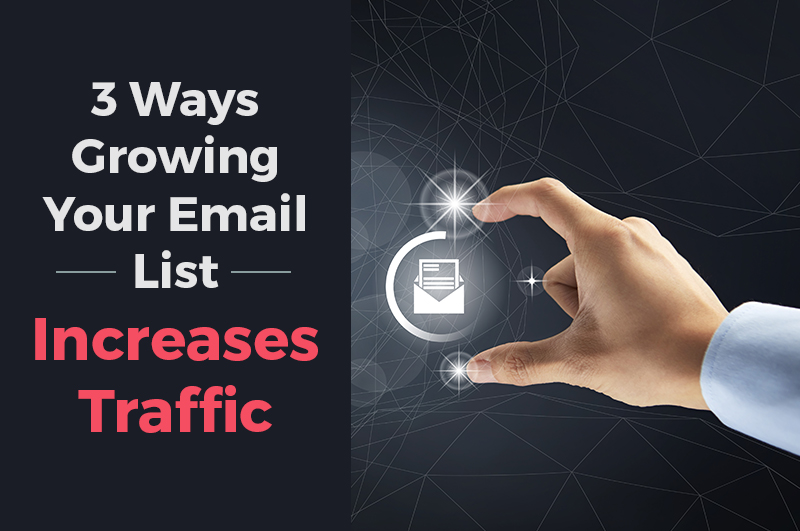Some people say that email is dead.
And with all of the other various outlets for communication online – like Facebook, Twitter, Instagram, etc. – it might be tempting to agree with them.
But, for the record, email is far from dead. In fact, email marketing in particular can provide quite a few benefits for your business.
For starters, email marketing sees on average a 4,300% return on investment (ROI), making it not only affordable but also extremely effective.
And then there’s the simple fact that people are always checking their emails, with 91% of all consumers reportedly checking their email on a daily basis.
So, as you can see, email is far from dead.
[kudanileads_on_click_intent optin_id=optin_13]
Free Download: Increase traffic by growing your email list. Learn how – grab your copy of this article in PDF and jump start your business today.
[/kudanileads_on_click_intent]
But what’s the point of all of this?
Well, if email is still kicking and email marketing yields such a consistently high return, what’s to say email can’t be used for other purposes?
Like, driving traffic back to your website, for example.
Wait…how can growing your email list increase traffic back to your website? Let’s take a quick look at the three top reasons right now.
#1 – Integrating Your Email with Your Blog Generates Cross Over Traffic

People love reading quality content that is both informative and interesting – it’s why you’re always encouraged to create and regularly maintain a blog on your website.
Plus, blogging is a great way to target specific keywords for SEO purposes, which in turn helps to bring more visitors back to your website.
So, if blogging is so great, and you generally spend quite a bit of time creating a single blog post, why not find a way to utilize that blog post in different formats?
That’s where email marketing comes into play.
It’s a fairly common practice. But essentially whenever you create a new blog post, you should get in the habit of sending out an email about it to notify your readers.
Not only does this method help to spread the word about your awesome new blog post, but it also provides you with the opportunity to reach an entirely new audience – and potentially draw that audience in — turning them into regular readers on your blog.
As you continue to grow your email list, adding new subscribers, you’re only creating a larger audience for your blog posts to reach going forward. And with more people potentially reading, you’ll start to see an increase in overall traffic back to your website, coming directly from the blog-centered email campaigns that you send out.
#2 – Taking Advantage of the SEO Factor Helps to Draw Traffic In

SEO – aka Search Engine Optimization – plays a huge role in driving more traffic back to your website. It primarily helps to increase your website’s rankings in the search engines. One of the main ways in which businesses can help to boost their own SEO is through properly optimized and targeted blog posts.
The strategy is relatively simple. First, you start with a given keyword that you’d like your website to rank for in the search engines. Then, you begin to incorporate that keyword into key sections of your blog post, including:
- The Headline (H1 Tags)
- The Subheads (H2 Tags)
- The Body of the Post (Spread evenly throughout the post.)
- Meta Tags
- Anchor Text (Text that links out to different pages on yours or other’s websites.)
- Image Alt Tags
Then, once the keyword is placed and the post is optimized, your blog is ready to be shared with the world via your website.
Again, this is a fairly common practice when it comes to blogging and SEO – so why not give it a try in your emails?
When you send out your blog posts via email for that audience to read, it’s a great idea to incorporate these same concepts – keywords in the headlines, subheads, body, tags, etc. – into your actual emails as well.
This is especially true when it comes to the anchor text you use to link from your emails back to your blog post(s) or website. Because that anchor text will play a role in the overall SEO of your blog/website, so you can really help to increase your rankings just by using simple anchor text with targeted keywords.
How is all of this related to increasing traffic back to your website? Again, it all comes back to SEO. The more time you spend optimizing your emails, the more people you’ll get back to your website and the more links you’ll establish, which in turn helps to increase traffic as a whole.
Plus, these SEO best practice also make for a much easier-to-read email that your audience is sure to engage with. Which leads us to the ever important Call to Action.
#3 – Using Calls to Action and Relevant Links Increases Your Click Through Rate

Image courtesy of Long Reads Blog
Calls to Action – sometimes referred to as CTA’s – are incredibly important for all types of digital marketing. Whether it be blog posts, web pages, landing pages, or emails, you spend a lot of time working on getting people to actually read your content all the way through to the end. So why wouldn’t you also give these same people something to do – or a “next step” to take – after taking the time to read through your content?
You totally would. Which is why there’s such a thing as a Call to Action.
Calls to Action can include a variety of different things, depending on what you’d like your readers to do directly after reading your blog post or email. For some, this might be signing up for a list, following your business on social media, making a purchase, or scheduling a consultation – the possibilities are endless.
But when it comes to emails, the most common Call to Action is going to be one that directs readers back to your website to learn more about your business. Because one of the main goals of any email marketing campaign is to drive traffic back to your website – and one of the best ways to do this is through a Call to Action.
This could easily be included at the bottom of a blog post that you’re sending out via email. Just a simple “Like What You See? Visit Our Blog to Read More,” with a button or link back to your blog can really help to direct new readers back to your blog.
Additionally, if you’re selling a particular product or service, or if you’re promoting a certain deal or special, you could use a Call to Action at the bottom of a promotional email to direct potential customers back to your website to learn more, make a purchase or connect with a customer service representative.
Sweet Tea LLC has some great advice in a recent article about calls to action. Here’s a tidbit from that post:
TIPS FOR IMPROVING CALLS-TO-ACTION
- Do use calls-to-action that make sense for your email content. For example, if you include a click-to-tweet, be sure the context of the tweet itself is directly related to whatever you’re talking about in your email.
- Don’t overload your emails with tons of calls-to-action. Be strategic about the calls-to-action you use in your emails. Try to stick to no more than 2 per email, like one click-to-tweet and a request to forward to a friend.
- Do engage with readers who use your calls-to-action. Like, retweet, and reply to people who share on Twitter. Respond to emails you receive. Essentially, be present and let people know you’re listening.
- Don’t hide your calls-to-action in the text. Make it obvious by using bold and/or underlined text, or include graphics or buttons for your calls-to-action. Make it hard for readers to miss what you’re asking them to do.
via How to Use Calls-to-Action to Increase Email Engagement | Sweet Tea, LLC
It’s really not rocket science – it’s just thinking like your readers or customers, and providing a logical next step for them in the sales/readership process.
And, of course, Calls to Action ultimately help to increase traffic back to your website. As more and more people sign up for your email list, you’ll begin to see more clicks back to your website – a direct result of using targeted Calls to Action.
BONUS – Incorporating Videos into Your Emails Can Help to Boost Traffic

Text and images on a page can definitely be engaging, but there’s just something about a well-shot, entertaining video that can really draw in a crowd.
And when it comes to emails, videos perform incredibly well. It’s actually been reported that including a video in your email can lead to a 200-300% increase in click-through rate – or visits back to your website.
It’s obvious that videos have an incredible impact on readers – just think about the last social media platform you visited. Where text-based posts and even images used to be the norm, you’ll now see a plethora of videos. It’s become the new normal – almost to be expected when it comes to interacting and engaging with readers online.
So if you’re really looking to kick up your email marketing campaign a notch and generate more click through traffic back to your website in the process, consider including a quality video within the body of your email. Even just a simple introduction video would be helpful – it doesn’t have to be lengthy or even fancy, just so long as it’s engaging.
The Importance of Growing Your Email List
Bottom line – the more people you get to sign up for your email list, the more who will see your emails, and the more who will follow those emails back to your website. Which is ultimately what you want, because once on your website, the possibilities are endless.
You might get a new blog reader, social media follower, brand advocate or even a loyal customer. Plus, the more people who visit the site, the more page views you’ll accumulate, which in turn helps to boost your rankings with the search engines.
And it all starts with growing your email list. So why not get started today?
[kudanileads_on_click_intent optin_id=optin_0]
Next Step: Download this article in a PDF (it was created with Designrr)
[/kudanileads_on_click_intent]
Other articles on email marketing that you NEED to read!
4 Hacks to Increase Your Opt-In Conversion Rate By 15x in 60 Minutes
Lead Magnets: Why They Fail and How to Fix It
6 Types of Lead Magnets You Should Be Using in Your Business
The Anatomy of a High Converting Lead Magnet
